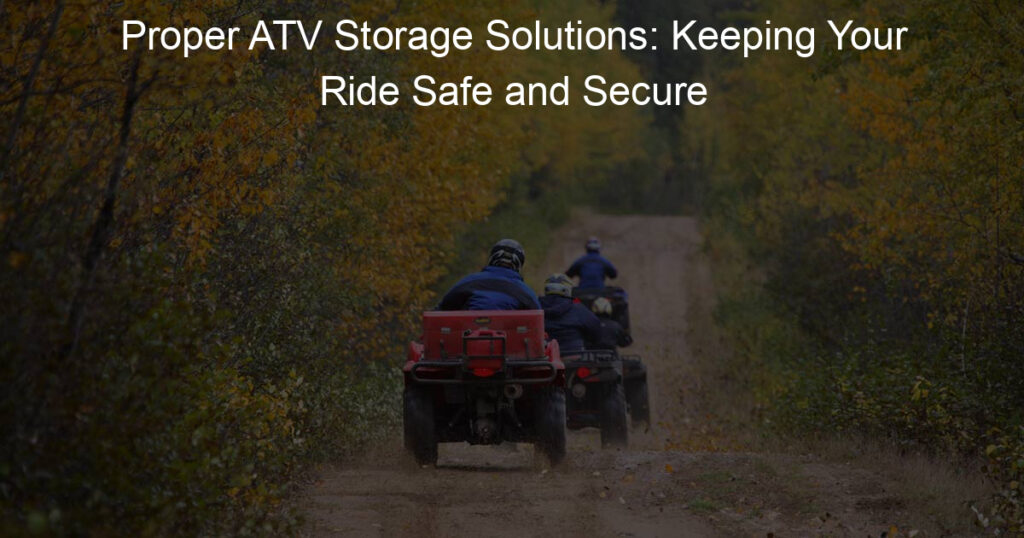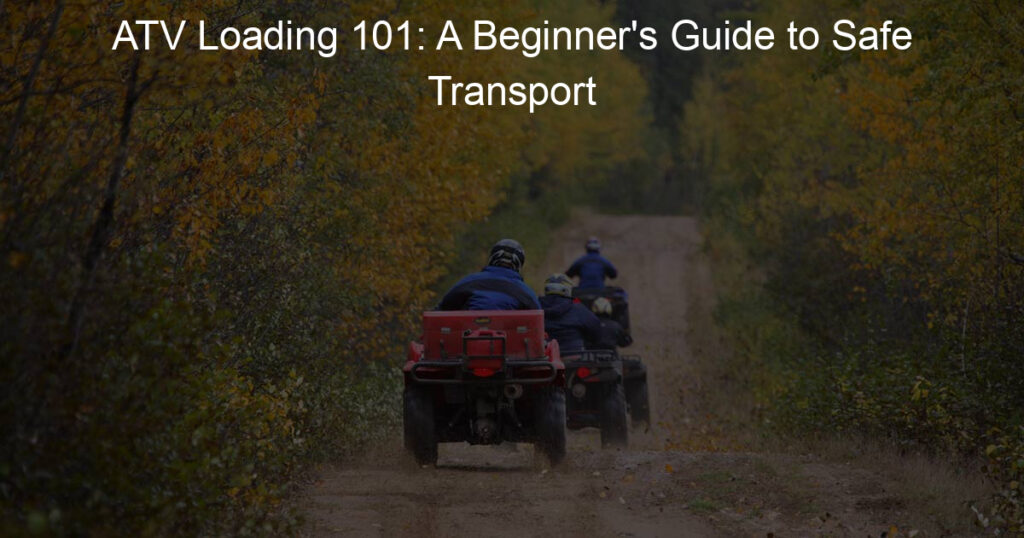As an avid ATV rider, I understand the importance of proper storage to keep my ride safe and well-maintained.
In this article, we will discuss proper ATV storage solutions to ensure that your vehicle is protected while you’re not using it.
Through adequate preparation and care, your beloved set of wheels can remain in peak condition for a long time. One of the many challenges faced by ATV owners is finding the right storage solution suited to their needs.
Some factors to consider include the availability of space, the potential risks posed by weather, and security concerns. ATV Storage solutions can be as simple as having a dedicated space in your garage or as advanced as renting a specialized storage unit.
During these considerable storage periods, it is critical to ensure your ATV is well-prepared and protected, as improper storage can lead to unnecessary issues down the line.
Now, let’s dive deeper into the topic of proper ATV storage solutions and explore ways to keep your ride in top shape.
Key Takeaways
- Proper storage solutions are crucial to maintaining your ATV’s condition
- Consider factors like space, weather, and security when choosing storage
- Preparing and protecting your ATV during storage ensures its longevity
Understanding ATV Storage Needs
As an ATV enthusiast, I know how important it is to keep my ride in optimal condition, especially during the off-season. Proper ATV storage ensures that my vehicle stays safe and ready for the next riding season.
In this section, I’ll share some tips and considerations for understanding ATV storage needs.
First and foremost, it’s essential to find a suitable location for storing the ATV. Ideally, a dry, well-ventilated, and temperature-controlled space like a garage or a dedicated storage unit will provide the best protection against damages caused by extreme temperatures and humidity.
Before storing my ATV, I make sure it’s clean and dry. I wash the exterior thoroughly, removing any mud, dirt, or debris that might have accumulated during my rides. Doing this prevents corrosion and potential damage to the paint and other components.
A crucial step in proper ATV storage is preparing the fuel system. I always fill up the gas tank and add a fuel stabilizer before storing my ATV for an extended period. This prevents condensation from forming inside the tank and keeps the fuel fresh for the next time I’m ready to ride.
Tire maintenance is also important when it comes to ATV storage. I check the tire pressure and inflate them to the recommended level before stowing my vehicle away. This prevents flat spots from developing and prolongs the life of my tires.
Lastly, I protect my ATV with a high-quality cover to keep it safe from dust, dirt, and potential scratches. A cover with ventilation flaps also helps reduce the buildup of moisture, reducing the chances of mildew or mold formation.
Factors Affecting ATV Storage
As an ATV owner, I’m aware of the various factors that can impact my ride’s storage. Some key elements that can affect my ATV during storage are rain, sun, moisture, rust, wind, and exposure to the elements, resulting in corrosion.
Rain can cause water to collect in various parts of my ATV, leading to rust and corrosion. Continuous exposure to the sun can lead to the fading or cracking of my ride’s plastics and other components, greatly diminishing its value and aesthetics.
Moisture, in general, can be harmful, particularly in the presence of metal, creating an ideal environment for rust to develop over time.
To protect my ATV from wind, I choose a storage location that offers some form of windbreak. This could be anything from a fence to a row of trees, as long as it helps reduce the impact of wind on my ride.
In windy conditions, flying debris can cause scratches and other potential damage to the vehicle.
When it comes to exposure to the elements, it is inevitable that my ATV will face some level of it. Nevertheless, the goal is to minimize this exposure as much as possible.
For instance, when my ride is stored outdoors, I invest in a high-quality, well-fitting cover designed specifically for ATVs. This cover protects against rain, sun, and other environmental factors.
In my experience, indoor storage solutions are always the best choice if available. Storing my ATV in a garage, shed, or other climate-controlled environment helps maintain its appearance and performance.
It keeps the vehicle away from excessive moisture, direct sunlight, and fluctuating temperature changes that can cause damage over time.
In conclusion, keeping my ATV safe and well-maintained while in storage is essential for its longevity and performance. By understanding the factors that can affect my ride and taking appropriate precautions to address them, I ensure that my ATV stays in excellent condition for years to come.
Choosing the Right ATV Storage Location
When it comes to storing my ATV, I have several options to consider. Ultimately, the key is to find a space that is safe, secure, and well-suited to protect my vehicle from the elements. Here are a few of my favorite options:
When I have the space for it, I prefer to keep my ATV in a garage. This indoor storage solution keeps my ride safe from the elements and potential thieves. Garages provide a controlled environment and are sturdy enough to protect my ATV from harsh weather conditions.
If given the option, a garage would always be my first choice.
If a garage isn’t available or doesn’t provide enough space, a shed can be a great alternative. Sheds still offer protection from the elements, and depending on the structure, they can provide a decent level of security.
One thing to keep in mind is ensuring that the shed has enough space to accommodate my ATV, as well as any additional gear or equipment that I need to store.
A storage unit is another excellent option for keeping my ATV secure. Most storage facilities offer 24/7 access, security measures like cameras and gates, and various unit sizes to accommodate my vehicle.
Climate-controlled units can be particularly useful for managing temperature and humidity, ensuring my ATV stays in the best condition possible.
Unfortunately, indoor storage isn’t always an option, and in these cases, outdoor storage may be the only viable choice. When storing my ATV outdoors, I make sure to use a durable, weatherproof cover specifically designed for ATVs.
It’s essential to protect my ride from harmful UV rays, rain, snow, and other elements that could cause damage.
Regardless of which option I pick, there are things to consider when choosing the best location for my ATV. Always prioritize security, accessibility, and adequate protection from the weather. By keeping these factors in mind, I can ensure my ATV stays safe and ready for my next adventure.
Preparing Your ATV for Storage
Cleaning Your ATV
Before storing my ATV, it’s essential to give it a thorough cleaning. I like to start by removing any dirt, mud, and debris using water, soap, and a soft brush. Paying attention to the areas around the wheels and engine will ensure that my ride is free of contaminants.
Once done, I always dry my ATV with a clean cloth to prevent rust.
Checking ATV Tires
Now that my ATV is clean, I need to check the tires. First, I inspect them for any visible signs of wear, punctures, or damage. Then, I ensure they’re properly inflated. To prevent flat spots or unnecessary stress, I use a tire stand or lift my ATV off the ground during storage.
Dealing with ATV Fuel Systems
Before storage, I make sure the fuel system is well-protected. To do so, I add a fuel stabilizer to my tank and run the engine for a few minutes allowing it to circulate. This step prevents corrosion and varnish build-up. Afterward, I turn off the engine and shut the fuel valve.
Battery Care
To prevent battery discharge, I disconnect the battery from my ATV. It is important to store it in a cool, dry place with a slow charge applied. Regularly checking the battery’s voltage and maintaining a proper charge will prevent irreversible damage.
Oil and Filters Maintenance
Before storing my ATV, it is crucial to change the oil and filter.
Here’s how I do it:
- Drain old oil: I start by warming up the engine and then draining the old oil.
- Change the oil filter: After draining the old oil, I remove and replace the oil filter.
- Add new oil: Finally, I fill my ATV with new oil, ensuring to follow the manufacturer’s recommended type and quantity.
While changing the oil, I also clean and inspect the air filter. Changing it if necessary guarantees that my ATV’s engine stays protected during storage.
Protecting Your ATV During Storage
Using ATV Covers
One thing I find really helpful when storing my ATV is using an ATV cover. This simple yet effective solution helps keep my ride safe from dirt, dust, and other elements. I prefer using a high-quality cover specifically designed for ATVs rather than just a generic tarp or plastic sheet.
It ensures the best possible protection for my quad.
Protecting from Rodents
Rodents can be a real nuisance when it comes to storing any vehicle, including my ATV. To keep these pesky intruders at bay, I make sure to block any small openings in my storage area and set up some traps.
I also remove any food sources near my ATV, as they can attract rodents. This way, the only thing feasting on my ride is my eyes when I finally get to take it out again.
Dealing with Moisture
When I store my ATV, I know how important it is to keep it dry and safe from moisture. To do this, I use a few strategies. First, I make sure my storage area has proper ventilation to allow for good airflow. This helps prevent condensation and keeps my ATV dry.
Second, I use moisture-absorbing products, like silica gel packs, to help combat dampness. Placing these around my ATV helps whisk away any moisture buildup and protects it from rust and corrosion.
Incorporating these practices into my ATV storage routine has allowed me to keep my ride safe and protected, so it’s always ready for my next adventure!
Long-Term ATV Storage Solutions
When it comes to long-term ATV storage solutions, I have a few suggestions to help you keep your ride safe during those winter months or for extended periods of time when it’s not in use.
First, I recommend cleaning your ATV thoroughly before storing it. Dirt and mud can cause corrosion, so be sure to wash it off and let it dry completely. Also, apply a coat of wax to protect the finish and prevent rust.
Fuel can become stale and cause damage to your ATV’s engine, so it’s crucial to take care of the fuel system. I suggest adding fuel stabilizer to a full tank of gas and running the engine for a few minutes to circulate the stabilizer. Then, turn off the engine and close the fuel valve.
Protecting your ATV’s engine is essential during long-term storage. To avoid moisture buildup, I like to remove the spark plug and pour a small amount of engine oil into the cylinder. Then, I replaced the spark plug and turned the engine over a few times to distribute the oil evenly.
Battery maintenance is another important aspect of long-term storage. I recommend disconnecting the battery and storing it in a cool, dry place. You can also use a battery maintainer or trickle charger to keep it charged throughout the storage period.
Lastly, I find it crucial to provide proper protection for your ATV during the winter or longer periods of storage. Using a high-quality, breathable cover can shield your ride from dust, moisture, and sunlight.
Also, if possible, store your ATV in a climate-controlled environment to minimize temperature fluctuations and humidity.
Following these techniques can be confident that your ATV will remain in top condition and be ready for use when the time comes.
ATV Storage Accessories
As an ATV enthusiast, I know the importance of keeping our ride safe and well-maintained, especially when it comes to storage. I would like to share with you some of my personal go-to ATV storage accessories that I’ve found helpful in keeping everything in order and ensuring a longer life for my ATV.
First on my list is always a good gear storage bag. I prefer using heavy-duty, water-resistant gear bags to stow away my riding equipment, such as helmets, gloves, goggles, and boots. These bags help keep my gear clean and dry and protect them from dust and debris.
Next up are the basic tools any ATV owner should have. A small toolkit containing essentials like wrenches, pliers, tire pressure gauges, and a multi-tool can go a long way in making sure my ATV stays in great condition.
I make sure to regularly check and tighten any loose nuts and bolts and keep my tires properly inflated for optimum performance.
One accessory I can’t recommend enough is a battery tender. Batteries can lose charge over time, especially in colder climates or when the ATV is in storage for a while.
A battery tender helps maintain a proper charge, preventing damage to the battery and ensuring that my ATV is ready to go whenever I am.
An airbox cover has proven to be a crucial accessory for me, especially during storage. This helps prevent water and debris from entering the airbox and potentially damaging the engine.
It’s definitely a must-have for those who want to protect their investment and keep their ATVs running smoothly.
There are plenty of other ATV accessories available, but these are some of the essentials that I have found most useful for proper storage and keeping my ride safe.
By investing in these essential storage accessories, I know I am taking the best possible care of my ATV and ensuring lasting performance and enjoyment.
Maintaining Your Stored ATV
When it comes to storing my ATV, I always make sure it’s maintained properly to keep it in top condition. One of the first things I do is charge the battery. I’ll either disconnect it and store it separately, or I’ll connect it to a trickle charger to keep it at the optimal voltage.
Before storage, I also treat my fuel system. I add a fuel stabilizer to the gas tank and run the engine for a few minutes to circulate it through the carburetor and other fuel system components.
This helps prevent any buildup and ensures my ATV will run smoothly when I take it out again.
When considering other aspects of my ATV’s engine, I make sure to lubricate key parts. I check the condition of the oil, change it if necessary, and take care of greasing points in the suspension and other moving parts.
Lubrication is crucial to prevent corrosion and keep everything running smoothly.
Next, I move to the UTV’s chain. The chain should be cleaned and lubricated, especially if you need to store your ATV for an extended period. This helps prevent rust and increases the chain’s lifespan.
As for the physical storage aspect, I always try to keep my ATV off the ground to relieve pressure on the suspension and tires. This can be achieved by using a suitable ATV stand or blocks for support.
It’s also important to have easy access to the stored ATV, so I can perform regular check-ups, ensuring that everything is in proper order. I take great pride in my equipment, and keeping my ATV stored properly is an essential part of protecting my investment.
Promoting ATV Safety in Storage
As an ATV enthusiast, I understand the importance of keeping my ride safe and well-maintained. Proper storage plays a huge role in this. Storing an ATV safely helps prevent damage, keeps it cool, and reduces the chance of corrosion from contaminants like mud and dirt.
Before storing my ATV, I make sure to clean it thoroughly, particularly from mud and dirt. Washing it off will prevent contaminants from causing corrosion, which can lead to expensive repairs down the road. I also gently scrub the cables and rough terrain components with a brush to remove any grime.
Once it’s clean and dry, I park my ATV on a hard, flat surface, away from direct sunlight. This helps preserve the tires and paint job and keeps my ride cool. I ensure there is adequate ventilation in the area and keep food and other contaminants away to prevent attracting rodents or insects.
To protect my ATV from potential damage, I secure it with tie-downs, making sure they are tight enough to keep it steady but not so tight as to strain the suspension or cables.
It’s essential to double-check the post I anchor my tie-downs on to ensure it is sturdy and reliable.
Taking these steps to promote safety in ATV storage is crucial for preserving the longevity and performance of my ride. By being proactive and staying vigilant, I can enjoy many more adventures on the trails.
Conclusion
As a fellow ATV enthusiast, I understand the importance of keeping our rides safe and well-maintained. Proper ATV storage is essential to achieving that goal. By following a few simple steps, we can ensure our ATVs remain in top condition and ready for adventure.
Firstly, investing in a quality storage solution, such as a cover or shed, is crucial. It protects our ATVs from the elements and external damage, reducing potential repair costs. Further, it is essential to keep our ATVs clean and apply protective treatments to prevent rust and corrosion.
Performing routine checks on our ATVs – including tire pressure, fluids, and battery life – is helpful in maintaining overall performance. Disconnecting the battery and draining the fuel tank during long-term storage keeps our rides in optimal condition, even when not in use.
Lubricating essential parts, like the chain and sprockets, is another way we can contribute to the long life of our ATVs.
Lastly, security measures such as disc locks, alarms, or GPS trackers should not be overlooked. The security of our valuable investments should always be a priority.
In conclusion, proper ATV storage is more than just finding a place to park. It’s about preserving our rides, maximizing their lifespan, and ensuring their safety for years to come.
With appropriate care and attention, we can all enjoy a thrilling and worry-free experience.
Safe riding, my friends!
Frequently Asked Questions
How can I protect my ATV during long-term storage?
To protect my ATV during long-term storage, I make sure to clean it thoroughly, removing any dirt, grease, or grime to prevent rust or corrosion. I also make sure to fill up the fuel tank and add fuel stabilizer to prevent any fuel-related issues.
Moreover, I remove the battery, store it in a separate, dry location, and maintain it with a battery tender.
What are effective ways to prevent rust and damage in outdoor ATV storage?
When storing my ATV outdoors, I start by applying a layer of wax or rust preventative to all exposed metal surfaces. If my ATV is equipped with a chain, I clean and lubricate it to prevent rust. I also use a high-quality, UV-protected cover to shield my ATV from the elements.
Furthermore, I choose a well-ventilated area that is higher off the ground, avoiding direct contact with wet or damp surfaces.
Which type of cover is best for protecting my ATV from the elements?
I prefer a cover made of durable, water-resistant materials, such as polyester or heavy-duty vinyl, to protect my ATV from the elements. A cover with UV protection and ventilation will help reduce mold and mildew formation.
Secure straps or drawstrings ensure a snug fit and prevent the cover from being blown away during windy conditions.
What maintenance should I perform before storing my ATV?
Before storing my ATV, I perform general maintenance, such as checking and inflating the tires to the correct pressure, changing the oil and oil filter, and inspecting the brakes, suspension, and other components.
I lubricate any moving parts, such as cables, and apply grease to all necessary fittings.
How can I secure my ATV from theft during storage?
To secure my ATV from theft, I use a high-quality lock and chain to secure it to a stationary object. I also remove any valuable accessories or equipment and store them separately.
Additionally, I am considering installing an alarm system or GPS tracking device on my ATV for added security.
What are the benefits of using a storage shed for my ATV?
Using a storage shed for my ATV offers several benefits. It provides a secure and sheltered space, protecting the ATV from harsh weather conditions, water damage, and UV exposure. A storage shed allows me to organize and store additional tools, accessories, and maintenance supplies.
Moreover, a well-constructed shed can deter potential thieves, keeping my ATV safe from theft.














